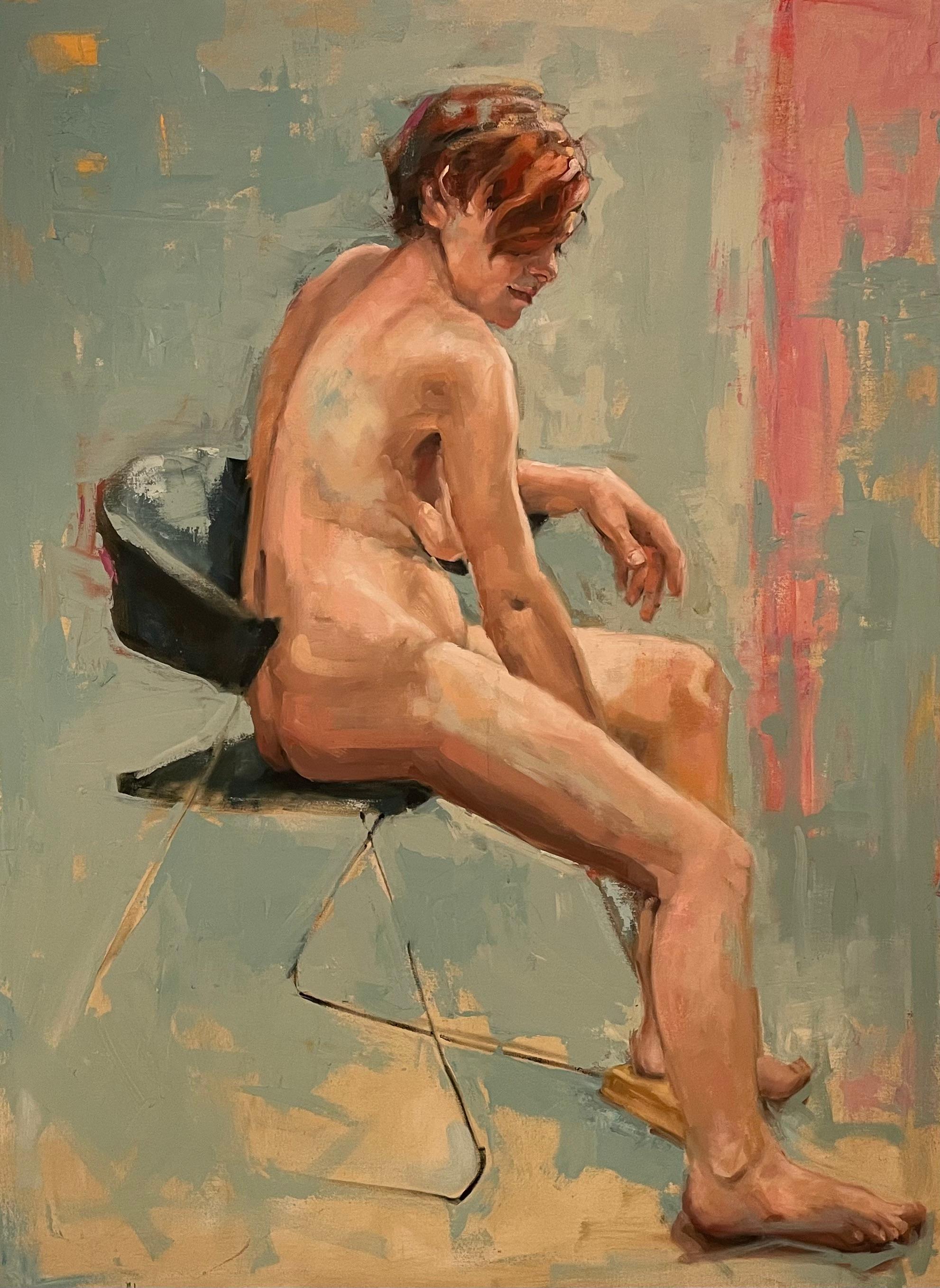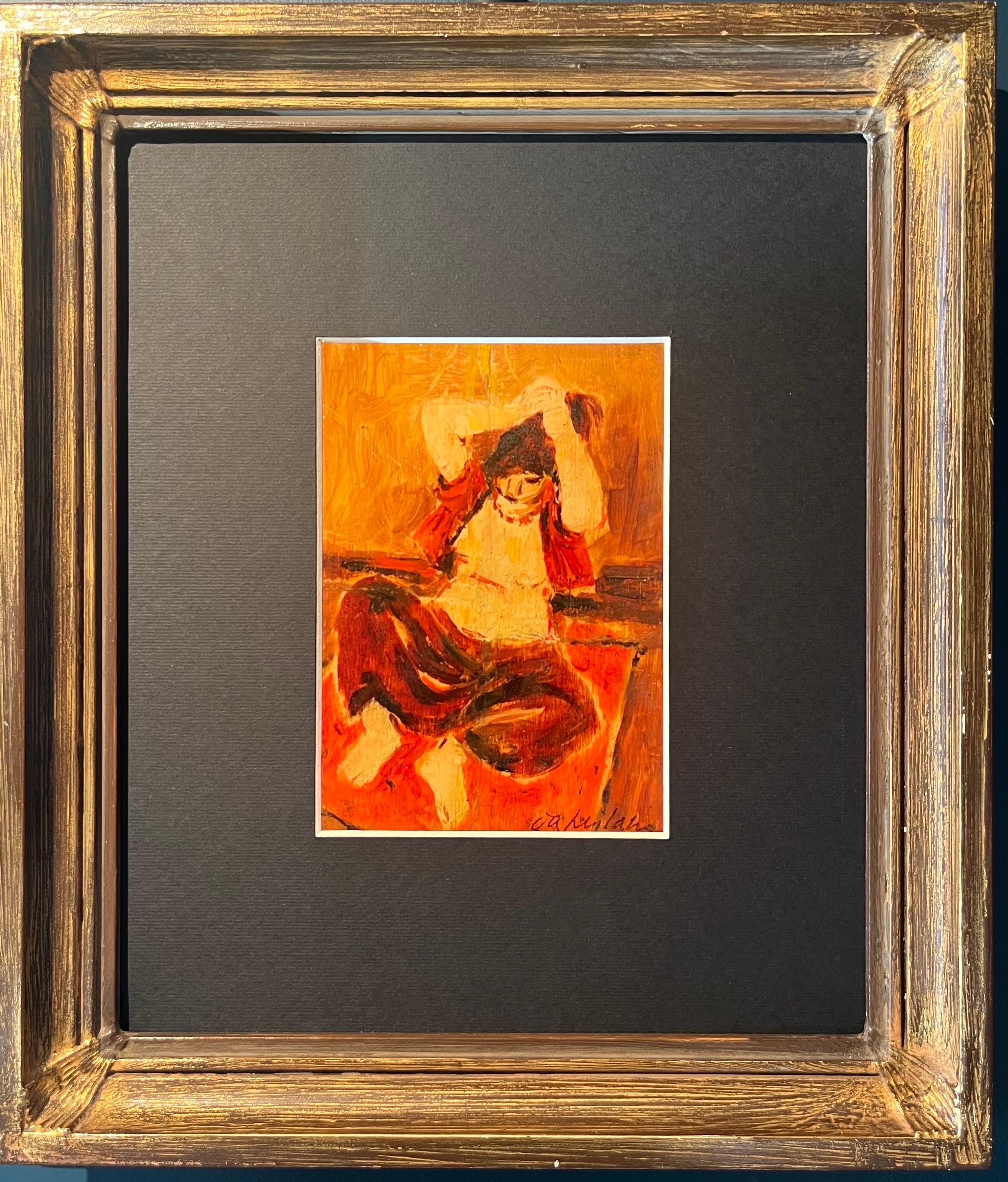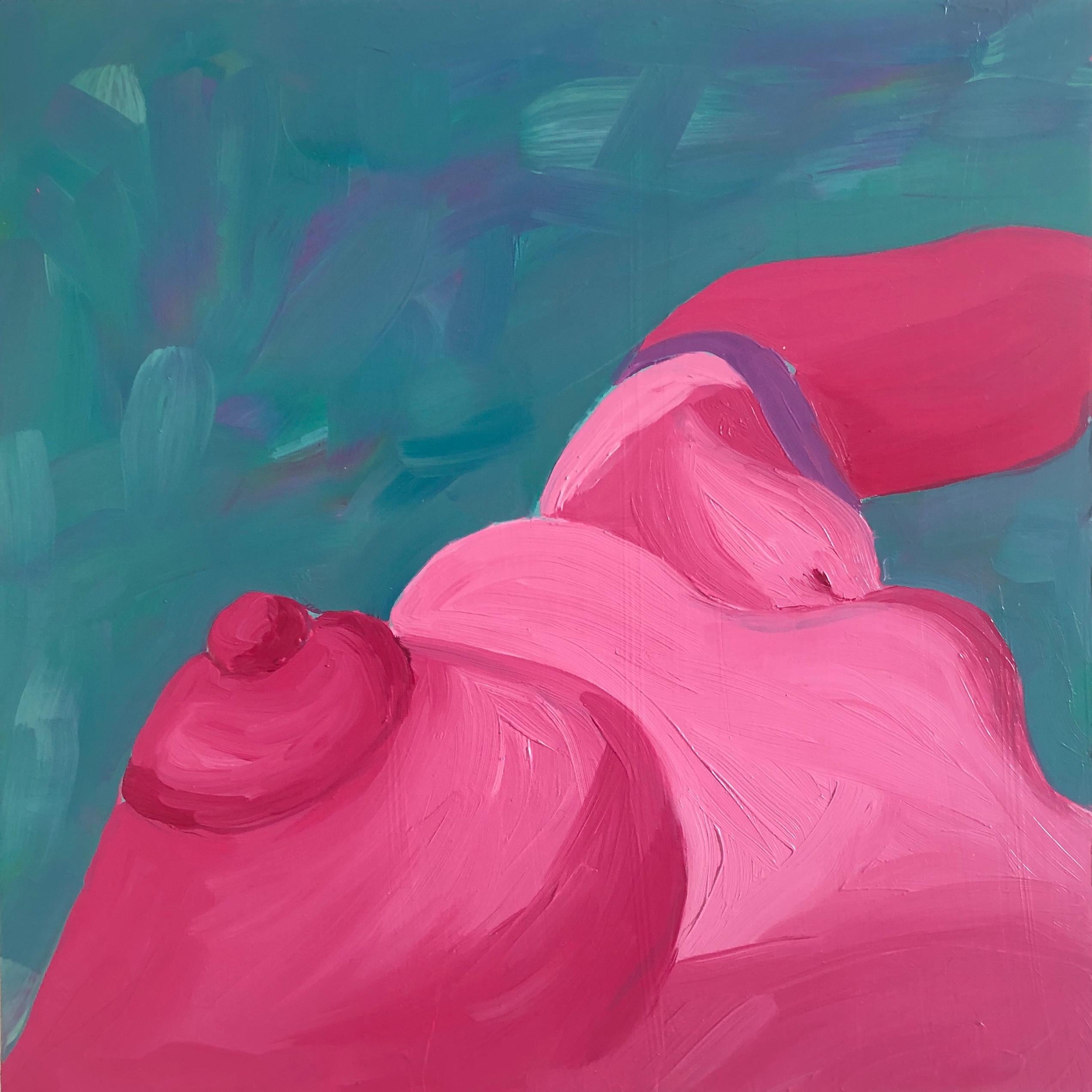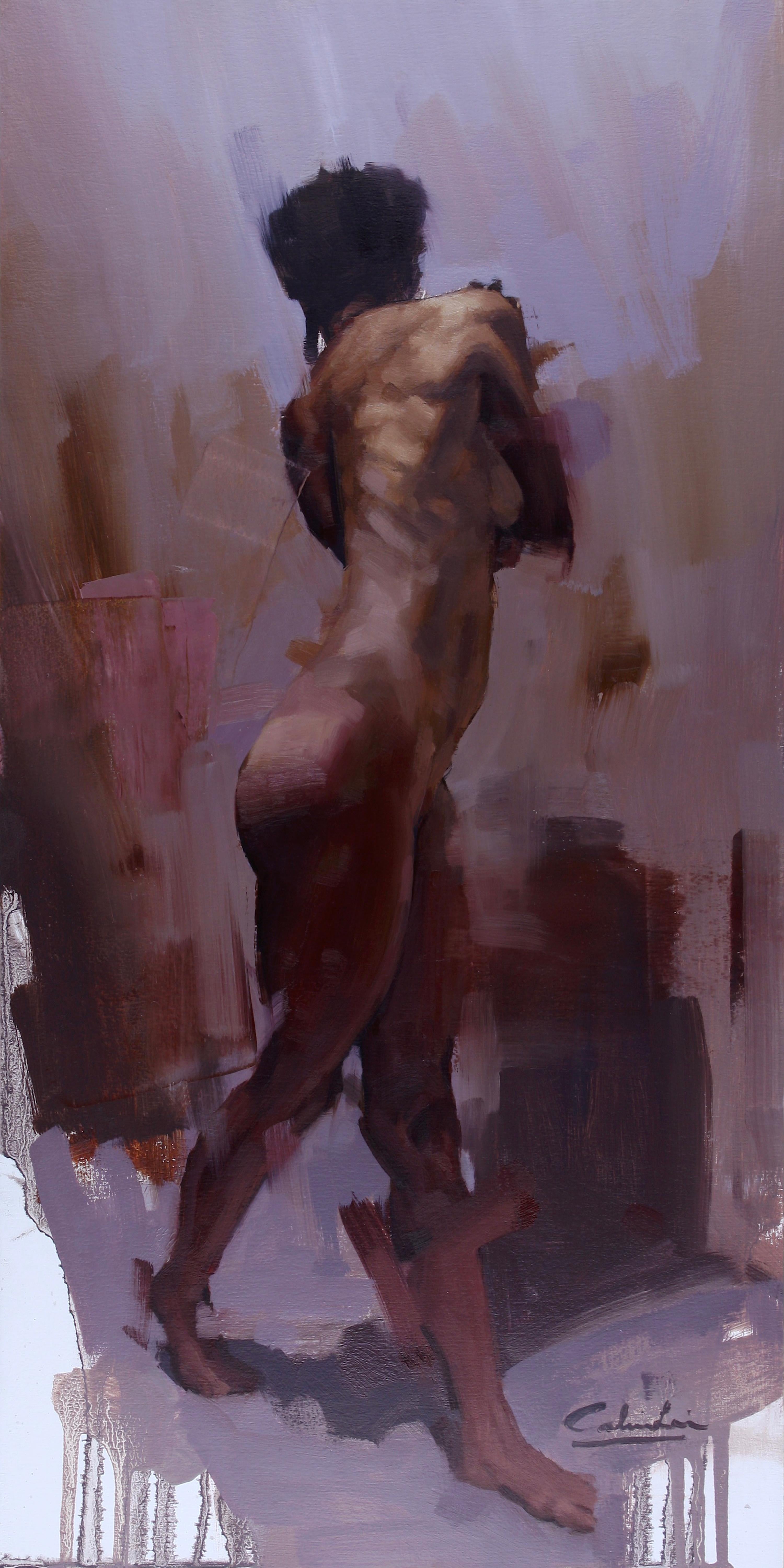Items Similar to American Modernist Oil Painting Gestural Landscape WPA Artist Group of 10
Want more images or videos?
Request additional images or videos from the seller
1 of 5
Ben-Zion WeinmanAmerican Modernist Oil Painting Gestural Landscape WPA Artist Group of 10
About the Item
Born in 1897, Ben-Zion Weinman celebrated his European Jewish heritage in his visual works as a sculptor, painter, and printmaker. Influenced by Spinoza, Knut Hamsun, and Wladyslaw Reymont, as well as Hebrew literature, Ben-Zion wrote poetry and essays that, like his visual work, attempt to reveal the deep “connection between man and the divine, and between man and earth.”
An emigrant from the Ukraine, he came to the US in 1920. He wrote fairy tales and poems in Hebrew under the name Benzion Weinman, but when he began painting he dropped his last name and hyphenated his first, saying an artist needed only one name.
Ben-Zion was a founding member of “The Ten: An Independent Group” The Ten” a 1930’s avant-garde group, Painted on anything handy. Ben-Zion often used cabinet doors (panels) in his work. Other members of group included Ilya Bolotowsky, Lee Gatch, Adolf Gottlieb, Louis Harris, Yanhkel Kufeld, Marcus Rothkowitz (later known as Mark Rothko), Louis Schanker, and Joseph Solman. The Art of “The Ten” was generally described as expressionist, as this style offered the best link between modernism and social art. Their exhibition at the Mercury Gallery in New York held at the same time as the Whitney Annual Exhibition of Contemporary American Painting, included a manifesto concentrating on aesthetic questions and criticisms of the conservative definition of modern art imposed by the Whitney. Ben-Zion’s work was quickly noticed. The New York Sun said he painted “furiously” and called him “the farthest along of the lot.” And the triptych, “The Glory of War,” was described by Art News as “resounding.”
By 1939, The Ten disbanded because most of the members found individual galleries to represent their work. Ben-Zion had his first one-man show at the Artist’s Gallery in Greenwich Village and J.B. Neumann, the highly esteemed European art dealer who introduced Paul Klee, (among others) to America, purchased several of Ben-Zion’s drawings. Curt Valentin, another well-known dealer, exhibited groups of his drawings and undertook the printing of four portfolios of etchings, each composed of Ben-Zion’s biblical themes.
Ben-Zion’s work is represented in many museums throughout the country including the Metropolitan, the Whitney, and the Museum of Modern Art in New York, the Art Institute of Chicago, the Philadelphia Museum of Art and the Phillips Collection, Washington. The Jewish Museum in New York opened in 1948 with a Ben-Zion exhibition.
“Ben-Zion has his hands on the pulse of the common man and his natural world”
As he emerged as an artist Ben-Zion never lost his gift for presenting the ordinary in ways that are vital, fresh and filled with emotions that are somber and exhilarating, joyous and thoughtful, and ultimately, filled with extraordinary poetic simplicity.
Ben-Zion consistently threaded certain subject matter—nature, still life, the human figure, the Hebrew Bible, and the Jewish people—into his work throughout his life. "In all his work a profound human feeling remains. Sea and sky, even sheaves of wheat acquire a monolithic beauty and simplicity which delineates the transient as a reflection of the eternal. This sensitive inter- mingling of the physical and metaphysical is one of the most enduring features of Ben-Zion's works." (Excerpt from Stephen Kayser, “Biblical Paintings,” The Jewish Museum Catalogue, 1952).
Ben-Zion continued his style of representational painting based on the abstract, and is perhaps best known for his Biblical paintings and etchings.
Ben-Zion received an American Jewish Congress award.
In 1987, Ben-Zion died in his home in the Chelsea section of Manhattan. He was 90 years old.
- Creator:Ben-Zion Weinman (1897 - 1987, American)
- Dimensions:Height: 14 in (35.56 cm)Width: 6 in (15.24 cm)
- Medium:
- Movement & Style:
- Period:
- Condition:minor wear.
- Gallery Location:Surfside, FL
- Reference Number:1stDibs: LU38213548232
About the Seller
4.9
Platinum Seller
These expertly vetted sellers are 1stDibs' most experienced sellers and are rated highest by our customers.
Established in 1995
1stDibs seller since 2014
1,548 sales on 1stDibs
Typical response time: 1 hour
- ShippingRetrieving quote...Ships From: Surfside, FL
- Return PolicyA return for this item may be initiated within 3 days of delivery.
More From This SellerView All
- American Modernist Oil Painting Nude Male on Beach WPA Artist Group of 10By Ben-Zion WeinmanLocated in Surfside, FLBorn in 1897, Ben-Zion Weinman celebrated his European Jewish heritage in his visual works as a sculptor, painter, and printmaker. Influenced by Spinoza, Knut Hamsun, and Wladyslaw Reymont, as well as Hebrew literature, Ben-Zion wrote poetry and essays that, like his visual work, attempt to reveal the deep “connection between man and the divine, and between man and earth.” An emigrant from the Ukraine, he came to the US in 1920. He wrote fairy tales and poems in Hebrew under the name Benzion Weinman, but when he began painting he dropped his last name and hyphenated his first, saying an artist needed only one name. Ben-Zion was a founding member of “The Ten: An Independent Group” The Ten” a 1930’s avant-garde group, Painted on anything handy. Ben-Zion often used cabinet...Category
Mid-20th Century Expressionist Figurative Paintings
MaterialsOil, Board
- Rare Modernist Oil Painting Line Drawing Nude Man Louis StettnerBy Louis StettnerLocated in Surfside, FLSigned and Dated Modern Line Drawing Oil Painting of Nude Man. Louis Stettner (November 7, 1922 – October 13, 2016) was an American photographer of the 20th century whose work included streetscapes, portraits and architectural images of New York and Paris. His work has been highly regarded because of its humanity and capturing the life and reality of the people and streets. Starting in 1947, Stettner photographed the changes in the people, culture, and architecture of both cities. Stettner also spent significant time sculpting and painting, as well as mixing his work and “painting” on some of his photographic images. He continued to photograph New York and Paris up until his death. Louis Stettner was born in Brooklyn, New York, to Austrian immigrant parents where he was one of four children. His father was a cabinet maker, and Louis learned the trade when young, using the money he earned to support his growing love of photography. He decides to be a photographer after seeing photographs by Alfred Stieglitz and Weegee. He was given a box camera as a child, and his love affair with photography began. His family went on trips to Manhattan and visited museums, including the Metropolitan Museum of Art, where his love of art began. At 18, in 1940, Stettner enlisted in the United States army and became a combat photographer in Europe for the Signal Corps. After a brief stint in Europe he was sent to New Guinea, the Philippines, and Japan. Back from the war he joined the Photo League in New York. Through the Photo League’s exhibits, Stettner was further exposed to the work of Weegee, Edward Weston, and Lewis Hine. Stettner visited Paris in 1946 and in 1947 moved there. From 1947 to 1949 he studied at the "Institut des Hautes Études Cinématographiques" in Paris and received a Bachelor of Arts in Photography & Cinema. He went back and forth between New York and Paris for almost two decades and finally settled permanently in Saint-Ouen, near Paris, in 1990. Stettner still frequently returned to New York. Stettner's professional work in Paris began with capturing life in the post-war recovery. He captured the everyday lives of his subjects. In the tradition of the Photo League, he wanted to investigate the bonds that connect people to one another. In 1947 he was asked by the same Photo League to organize an exhibition of French photographers in New York. He gathered the works of some of the greatest photographers of the era, including Robert Doisneau, Brassaï, Edouard Boubat, Izis Bidermanas, and Willy Ronis. The show was a big success and was largely reviewed in the annual issue of U.S. Camera. Stettner had begun a series of regular meetings with Brassaï who was a great mentor and had significant influence on his work. In 1949, Stettner had his first exhibition at the "Salon des Indépendants" at the Bibliothèque Nationale, Paris. In 1951 his work was included in the famous Subjektive Fotografie exhibition in Germany. During the 1950s he free-lanced for Time magazine, Life, Fortune, and Du (Germany). While in Paris he reconnected with Paul Strand, who had also left New York because of the political intolerance of the McCarthy era—Strand had been a founder of the Photo League that would be blacklisted and then banned during those years. In the 1970s Stettner spent more time in New York City, where he taught at Brooklyn College, Queens College, and Cooper Union. In his own social realist work, Stettner focused on documenting the lives of the working class in both Paris and New York. He felt that the cities belong to the people who live there, not to tourists or visitors. His upbringing caused him to take great care in capturing the simple human dignity of the working class. He also captured noteworthy architectural images of both cities, including bridges, buildings, and monuments. Stettner produced well-known silver gelatin prints in fine images, including: Aubervilliers, Brooklyn Promenade...Category
21st Century and Contemporary American Modern Figurative Paintings
MaterialsCanvas, Oil
- Nude Mermaid Under Sea, German Outsider Folk Art OIl PaintingBy Hajo MalekLocated in Surfside, FLFantasy Nude Mermaid German outsider Naive artist born in 1922. has exhibited in Germany in 1969 worked in painting, gouache and linocuts. Expressionist Folk Art style. Art brut, pr...Category
1990s Outsider Art Figurative Paintings
MaterialsCanvas, Oil
- Simka Simkhovitch WPA Artist Painting Gouache American Modernist Beach SceneBy Simka SimkhovitchLocated in Surfside, FLSimka Simkhovitch (Russian/American 1893 - 1949) This came with a small grouping from the artist's family, some were hand signed some were not. These were studies for larger paintings. Simka Simkhovitch (Симха Файбусович Симхович) (aka Simka Faibusovich Simkhovich) (Novozybkov, Russia May 21, 1885 O.S./June 2, 1885 N.S.—Greenwich, Connecticut February 25, 1949) was a Ukrainian-Russian Jewish artist and immigrant to the United States. He painted theater scenery in his early career and then had several showings in galleries in New York City. Winning Works Progress Administration (WPA) commissions in the 1930s, he completed murals for the post offices in Jackson, Mississippi and Beaufort, North Carolina. His works are in the permanent collections of the Dallas Museum of Art, the National Museum of American Art and the Whitney Museum of American Art. Born outside Kyiv (Petrograd Ukraine) into a Jewish family who owned a small department store. During a severe case of measles when he was seven, Simcha Simchovitch sketched the views outside his window and decided to become an artist, over his father's objections. Beginning in 1905, he studied at the Grekov Odessa Art School and upon completion of his studies in 1911 received a recommendation to be admitted to the Imperial Academy of Arts. Though he enrolled to begin classes in architecture, painting, and sculpture at the Imperial Academy, he was dropped from the school roster in December because of the quota on the number of Jewish students and drafted into the army. Simchovitch served as a private in the 175th Infantry Regiment Baturyn [ru] until his demobilization in 1912. Re-enrolling in the Imperial Academy, he audited classes. Simka Simkhovitch exhibited paintings and sculptures in 1918 as part of an exhibition of Jewish artists and in 1919 placed 1st in the competition "The Great Russian Revolution" with a painting called "Russian Revolution" which was hung in the State Museum of Revolution. In 1922, Simkha Simkhovitch exhibited at the International Book Fair in Florence (Italian: Fiera Internazionale del Libro di Firenze). In 1924, Simkhovitch came to the United States to make illustrations for Soviet textbooks and decided to immigrate instead. Initially he supported himself by doing commercial art and a few portrait commissions. In 1927, he was hired to paint a screen for a scene in the play "The Command to Love" by Fritz Gottwald and Rudolph Lothar which was playing at the Longacre Theatre on Broadway. Art dealers began clamoring for the screen and Simkhovitch began a career as a screen painter for the theater. Catching the attention of the screenwriter, Ernest Pascal, he worked as an illustrator for Pascal, who then introduced him to gallery owner, Marie Sterner. Simkhovitch's works appeared at the Marie Sterner Gallery beginning with a 1927 exhibit and were repeated the following year. Simkhovitch had an exhibit in 1929 at Sterner's on circus paintings. In 1931, he held a showing of works at the Helen Hackett Gallery, in New York City and later that same year he was one of the featured artists of a special exhibit in San Francisco at the California Palace of the Legion of Honor in Lincoln Park. The exhibit was coordinated by Marie Sterner and included four watercolors, including one titled "Nudes". He is of the generation of Russian Soviet artists such as Isaac Pailes, Serge Charchoune, Marc Chagall, Chana Orloff, Isaac Ilyich Levitan, and Ossip Zadkine. In 1936, Simkhovitch was selected to complete the mural for the WPA Post office project in Jackson, Mississippi. The mural was hung in the post office and courthouse in 1938 depicted a plantation theme. Painted on the wall behind the judge’s bench, “Pursuits of Life in Mississippi”, a depiction of black workers engaged in manual labor amid scenes of white professionals and socialites, was eventually covered over in later years during renovations due to its stereotypical African American imagery. Simka painted what he thought was typical of Jackson. His impression of pre-civil rights Mississippi was evidently Greek Revival column houses, weeping willow trees, working class families, and the oppression of African Americans. He painted African American men picking cotton, while a white man took account of the harvest and a white judge advised a white family, calling it Pursuits of Life in Mississippi. Though clearly endorsed by the government and initially generally well-received, the mural soon raised concerns with locals as the climate toward racial segregation began to change. The main concern was whether depictions that show African Americans in subjugated societal roles should be featured in a courtroom. The following year, his painting "Holiday" won praise at an exhibition in Lincoln, Nebraska. In 1940, Simkhovitch's second WPA post office project was completed when four murals, "The Cape Lookout Lighthouse and the Orville W. Mail Boat", "The Wreck of the Crissie Wright", "Sand Ponies" and "Canada Geese" were installed in Beaufort, North Carolina. The works were commissioned in 1938 and did not generate the controversy that the Jackson mural had. The main mural is "The Wreck of the Crissie Wright" and depicts a shipwreck which had occurred in Beaufort in 1866. "The Cape Lookout Lighthouse and the Orville W. Mail Boat" depicted the lighthouse built in 1859 and the mail boat that was running mail during the time which Simkhovitch was there. The boat ran mail for the area until 1957. "Sand Ponies" shows the wild horses common to the North Carolina barrier islands and "Canada Geese" showed the importance of hunting and fishing in the area. All four murals were restored in the 1990s by Elisabeth Speight, daughter of two other WPA muralists, Francis Speight...Category
1930s American Modern Nude Paintings
MaterialsGouache, Board
- 2 Sided Expressionist Detroit Modernist Painting Female Nude, Night Cruise ShipLocated in Surfside, FLThis is a two sided painting. Nude reclining woman and a ship lit at night. Harold Cohn (1908 - 1982) Harold Cohn was active/lived in New Jersey, Michigan. Harold Cohn is known fo...Category
Mid-20th Century Modern Nude Paintings
MaterialsWatercolor, Gouache
- 2 Sided Expressionist Detroit Modernist Painting Female Nude, Night Cruise ShipLocated in Surfside, FLThis is a two sided painting. Nude reclining woman and a ship lit at night. Harold Cohn (1908 - 1982) Harold Cohn was active/lived in New Jersey, Michigan. Harold Cohn is known fo...Category
Mid-20th Century Modern Nude Paintings
MaterialsWatercolor, Gouache
You May Also Like
- "Young Woman Seated" Green & Pink Contemporary Figurative Nude by Shana WilsonBy Shana WilsonLocated in Carmel, CAIn "Nude Woman Seated," a 40" x 30" oil on wood panel by Shana Wilson, there is an intimate portrayal of vulnerability and quiet strength. The artist employs a soft, earth-toned palette, with shades of warm beige, muted greens, and accents of coral, to craft the figure’s delicate form. Wilson's loose, confident brushstrokes lend a raw, textured quality, while the interplay of light and shadow captures the natural curves of the human body. The solitary figure, caught in a moment of repose, exudes a contemplative air, inviting viewers to reflect on the complexities of the human form and the subtle narratives contained within stillness. About the Artist: Over seven billion souls exist on this planet, each with a unique face and story. Shana transfers her visceral love for the human landscape to canvas, tenderly cradling its peaks and valleys, darkness and light, colors and neutrals, empty and full, hard edges and soft curves. Each brush stroke creates a controlled cacophony as it assembles the intricate jigsaw of the human face. An entire life’s journey is written on this human landscape; a journey that begs to be documented and treasured. Shana’s legacy project is to paint inspirational women from all walks of life, inclusive of all cultures and orientations. The subjects all have one thing in common; the ability to inspire and create social change. She pays tribute to them on canvas, painting a long overdue celebration of trail-blazing women. Visit any major gallery or museum in the world and it is teeming with paintings of nude women...Category
21st Century and Contemporary Expressionist Figurative Paintings
MaterialsWood Panel, Oil
- "Red Odalisque" oil cm. 17 x 12 1947 Offer Free ShippingBy Giulio da MilanoLocated in Torino, ITred, odalisque,orange,yellow Giulio DA MILANO (Nizza, 1895 - Torino, 1990) Giulio Da Milano was a Giacomo Grosso's disciple and he was very close to the artists that used to patronize La Coupole de Montparnasse (from Kisling to Pascin, from Derain to Vlaminck). He is considered one of most representative exponents of the Turin’s artistic scene in the ‘30s-‘40s, close to the Gruppo dei Sei. His works can be found in the following museums: Turin, Modern Art Gallery...Category
1940s Expressionist Figurative Paintings
MaterialsWood Panel
- Ray (2020), figurative pink, purple, aqua & blue nude oil on wood panel paintingLocated in Jersey City, NJRay (2020), figurative pink, mauve, coral, purple, aqua, teal, mint green & blue nude portrait oil on wood panel painting Oil on wood panel Hand-signed by artist Framing available u...Category
2010s Feminist Nude Paintings
MaterialsWood Panel, Oil
- Blush (2020), hot pink nude figurative oil on wood panel painting, w/ turquoiseLocated in Jersey City, NJBlush (2020), figurative hot pink, light pink, fuchsia, magenta, lavender purple, aqua, turquoise & mint green nude portrait oil on wood panel painting Oil on wood panel Hand-signed...Category
2010s Feminist Nude Paintings
MaterialsWood Panel, Oil
- Glow, 2021, figurative mint green nude portrait, oil on wood panel paintingLocated in Jersey City, NJ"Glow" (2021) by Jessica Rubin, figurative mint green and blue nude portrait, oil on wood panel painting Oil on wood panel Hand-signed by artist Framing...Category
2010s Nude Paintings
MaterialsOil, Wood Panel
- "A Dream" Oil PaintingBy Calvin LaiLocated in Denver, COCalvin Lai's (US based) "A Dream" is an original, handmade oil painting that depicts a nude female figure in a Contrapposto posture turned away from the viewer and clutching her arms...Category
2010s Contemporary Nude Paintings
MaterialsOil, Wood Panel





